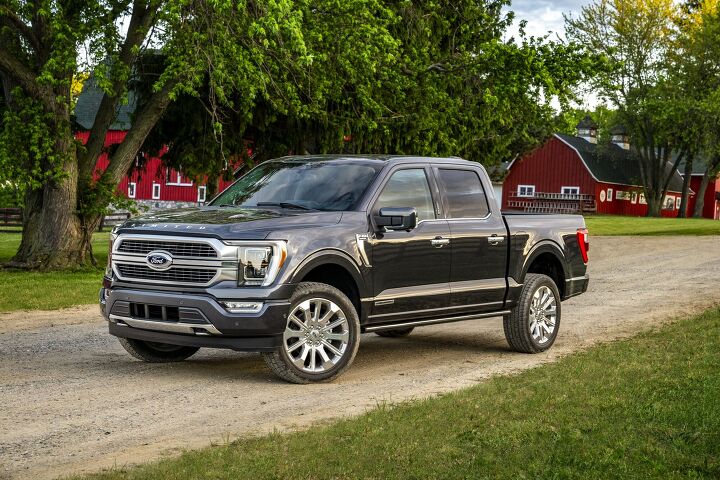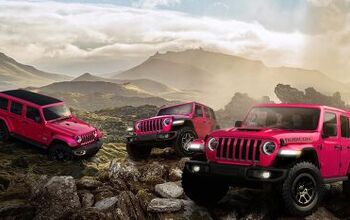Axios Says Trucks Are Big, Also Confirms Water is Wet

In a report which will surprise no American blessed with the gift of sight, a new report from the eggheads at Axios is the latest to exhort that today’s pickup trucks are just too damn big. To be clear, the study does a good job of breaking down some of the details but, as you’ll see after the jump, some of their illustrations may be a bit off the mark
The lead image superimposes what appears to this author’s jaundiced eye as a 1976 F-150 XLT regular cab long box, one of the first leaps Ford made from the F-100, up against a 2022 F-150 SuperCrew with the short box and a PowerBoost engine. It’s a jarring comparison, to be sure, but a quick search of dimensions is readily available.
For 1976, a Blue Oval truck spec’d like the one in the composite image should measure 205.3 inches in length. Contrast that with the modern-day pickup shown which is 231.7 inches long and you’ve got a whopping difference of 26.4 inches. That’s not a surprise, nor is it our issue. We’re instead pointing to the skiff of rear overhang, a space which is surely not 26.4 inches – at least not at the scale of the rest of the composite shown in the Axios post. If that part is off-kilter, what about the rest of the image?
We can argue until the cows come home about how trucks are too big or too small or important tools for farmers instead of urbanites – this is a polarizing debate that will not end any time soon. Rather, we’d like to posit a different argument, one which makes more sense to us than comparing a luxed-up F-150 SuperCrew with a bog-standard F-150 regular cab from decades ago. In those olden days, a regular cab F-150 was generally purchased for work duties and maybe hitting up the Tastee Freeze if it’s lucky. Today’s leather-lined SuperCrew is treated (and viewed by some) as a modern-day Town Car both in terms of status and function – even if many buyers will never cop to that comparison.
One of the tenets of this Axios article is the swing from ‘more bed’ to ‘more cab’. They are, of course, totally correct. But if we’re going to skewer the modern crew cab truck on that metric, let’s compare its footprint and interior volume to that of a luxury car – both recently and forty years ago – and regular cab trucks to, well, regular cab trucks.
You all can read numbers, so there’s no need to reiterate those shown in this chart. What we will explain is the footprint-to-volume number, one which was figured as the vehicle’s footprint divided by its interior passenger volume (lower numbers are better because math). A small footprint and large volume suggest a rig that is not outsized as a people hauler, a task given to crew cab trucks today and luxury cars of yore.
With those figures, we learn a 1983 Town Car isn’t much worse than a 2015 F-150 SuperCrew short box in terms of the space it provides passengers compared to the space it takes up on the road. Similarly, nor is a regular cab F-150 from those same two model years. What is different, of course, is the measure between the most popular body styles of F-150 in ’83 and ’15. Ergo, the complaint that ‘truckz are bigger’.
But – and this is the important part – there is not much disparity once one considers the purpose of these machines. Using our yardstick, the successful family scores a 147 while tootling around and showing off their wealth in a Town Car Cartier. A similar family today scores a 141 while doing the same thing in their F-150 Platinum.
And, for giggles, we calculated this newly-invented score for the most practical of all vehicles: The minivan. A new Chrysler Pacifica, measuring 204.3 inches long and 79.6 inches wide with 165 cubic feet of passenger space, earns a 99 on our scale – handily beating anything else we’ve talked about in this post.
That’s enough math, now. I’m going to have a drink of whiskey.
[Images: Ford, the author]
Become a TTAC insider. Get the latest news, features, TTAC takes, and everything else that gets to the truth about cars first by subscribing to our newsletter.

Matthew buys, sells, fixes, & races cars. As a human index of auto & auction knowledge, he is fond of making money and offering loud opinions.
More by Matthew Guy
Latest Car Reviews
Read moreLatest Product Reviews
Read moreRecent Comments
- Mike Beranek While the product may appear to be "better", only time will tell. The American automotive environment can chew a car up and spit it out. Will these Chinese EVs survive like a quarter-century old Cavalier, or will they turn out like VinFast's "cars"?
- Mike Beranek This police vehicle will be perfect for when the State of Florida starts tracking every pregnancy.
- Dave M. The Highlander hybrid, a larger, heavier vehicle, gets better mpgs. Why? Also, missed opportunity - if Toyota had made this a hatchback, they could have scooped up the "want a Tesla S but not ready for a full EV" crowd, however small or large they may be....
- TheMrFreeze Difficult call...the more the mainstream automakers discontinue their more affordable models and only sell crazy overpriced EVs and trucks, the more appealing the idea of letting in cheap imported cars becomes with the buying public. If the government is going to impose tariffs on Chinese vehicles, at the same time they need to be getting with the Big 3 and telling them to fill the void with affordable models and not use the tariff as an excuse to simply raise prices. Otherwise, public pressure could see the tariffs withdrawn.I seem to recall the last administration put a 25% tariff on Chinese steel, at which point the US manufacturers immediately used the opportunity to raise their prices 25%...that needs to not happen.
- Daniel J The real problem I see is it's about 8K too much. I'd prefer a lower trim but they don't offer enough HP for my tastes.


































Comments
Join the conversation
EBFlex,
Why are you comparing subsidies for petroleum to subsidies for a vehicle?
I didn't. Frankly, I don't know what subsidies are these days, for renewables. That would be the correct comparison. I very much doubt that the electricity we buy is only a third of its true cost, with subsidies covering the rest.
As you say, per-car subsidies are an advantage for EVs. Nurturing new industries is part of any government's mission, so we see EV subsidies in most countries. The Biden Administration is trying to shift the subsidies to encourage manufacturers to "build American", but is getting flak from Korea, which has invested heavily in EVs for the American market. We shall see...
Lou_BC,
What's your profession, if I may ask?